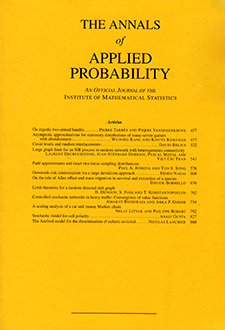Abstract
In this work we introduce the concept of Bures–Wasserstein barycenter , that is essentially a Fréchet mean of some distribution supported on a subspace of positive semi-definite d-dimensional Hermitian operators . We allow a barycenter to be constrained to some affine subspace of , and we provide conditions ensuring its existence and uniqueness. We also investigate convergence and concentration properties of an empirical counterpart of in both Frobenius norm and Bures–Wasserstein distance, and explain, how the obtained results are connected to optimal transportation theory and can be applied to statistical inference in quantum mechanics.
Funding Statement
The work of Alexandra Suvorikova and Alexey Kroshnin in Sections 2 and 3 is funded by Russian Science Foundation grant No. 18-71-10108. The work of Vladimir Spokoiny in Section 4 is supported by the Russian Science Foundation grant No. 19-71-30020. Vladimir Spokoiny thanks the Deutsche Forschungsgemeinschaft (DFG, German Research Foundation) under Germanyś Excellence Strategy—The Berlin Mathematics Research Center MATH+ (EXC-2046/1, project ID: 390685689).
Acknowledgments
Alexey Kroshnin is also affilated with National Research University Higher School of Economics, Russia, and Université Claude Bernard Lyon 1, France.
Vladimir Spokoiny is also affilated with Institute for Information Transmission Problems RAS, Russia, and National Research University Higher School of Economics, Russia.
Alexandra Suvorikova is also affilated with Institute for Information Transmission Problems RAS, Russia.
First of all, we would like to thank the anonymous referee who encouraged us consider in more detail a connection of Bures–Wasserstein barycenters to M-estimators. We are grateful to all referees who made a lot of useful comments and remarks which significantly improved the quality of the presentations.
The article was prepared within the framework of the HSE University Basic Research Program.
Citation
Alexey Kroshnin. Vladimir Spokoiny. Alexandra Suvorikova. "Statistical inference for Bures–Wasserstein barycenters." Ann. Appl. Probab. 31 (3) 1264 - 1298, June 2021. https://doi.org/10.1214/20-AAP1618
Information





